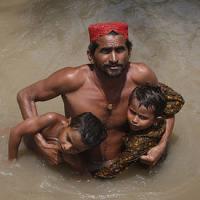
Hundreds of thousands displaced as flood worsens
Heavy monsoon rains have continued to lash most of the Sindh and wreaked havoc in the Badin and Mirpurkhas districts and many other districts in the province leaving over 30 people dead and a large number of injured due to roof collapses and rain-related incidents. Hundreds of villages are also submerged under floodwater which has ruined crops and thousands of acres of agricultural land.
On the surface, it seems like the problem is the monsoon rain that no one can control. But in reality, it is the mistakes and omissions in the planning of the “Left Band Outfall Drain” that have played the key role in the destruction.
The Left Bank Outfall Drain (LBOD) project was carried out by, amongst others, the World Bank, in an attempt to improve the irrigation system of Sindh and decrease the salinity of the soil.
But the LBOD has caused irreparable losses to agriculture, the environment and people’s livelihoods. It has caused the displacement of whole communities from one place to another. Throughout the history of last century, there is no evidence of any flood inundating the lower part of Sindh. Previous floods, before the construction of the LBOD, were diverted through natural drainage system The LBOD blocked them and prevented them from safely draining the monsoon rains.
As a result of the flooding, the Mirpurkhas district has suffered unforgettable destruction. More than 200,000 people have been forced to migrate to safer places, while more than 30,000 houses have been destroyed. Dozens of dam breaches have caused crop destruction. In Mirpurkhas district alone, 400,000 people are affected. More than 100 people each day are falling ill to stomach infections, malaria and skin diseases. Diseases are also spreading amongst livestock.
The floods have covered all of the Sindh. People who were already in the lap of poverty and had no access to clean water, have had their lands made useless. The Lower Sindh is facing a similar situation.
All these problems are multiplied because of the poor system of LBOD.
The education, irrigation, agriculture and livestock systems are totally destroyed. 90% of the houses are destroyed. The flood is continuing in more than 6 districts of Sindh.
The desperate situation is now threatening to get worse, following the outbreak of epidemics in the affected areas.
A large number of people are suffering from waterborne diseases, infections, skin and other health problems. This will worsen if immediate steps are not taken, because clean water and proper food are not available. Up to 90% of the cotton, chilies and the sugarcane crops have been washed out in Mirpurkhas.
Families living along the road have no access to food, clean drinking water, shelter or medicine. Many small children are suffering from skin infections, like boils and rashes, due to the flood water. People are suffering from fevers and there is high risk of a typhoid epidemic, viral fever, acute diarrhea, cholera, dysentery and bronchitis due to living in unhygienic conditions and being forced to wash in and drink flood water.
On the one hand, people are exposed to the floods by staying in their villages but at the same time they are very worried because they feel that if they leave their village, their slums will be destroyed forever and it won’t be possible to rebuild them.
Recognizing the danger inherent in the situation, our team from the Progressive Workers’ Federation Pakistan, responded rapidly. As soon as the rain began on 10 August our team members went to the site and helped the victims. We encouraged them to move to a safe place. We built two camps in Mirpur khas for our comrades and provided food and medicine for more than 200 people.

Be the first to comment